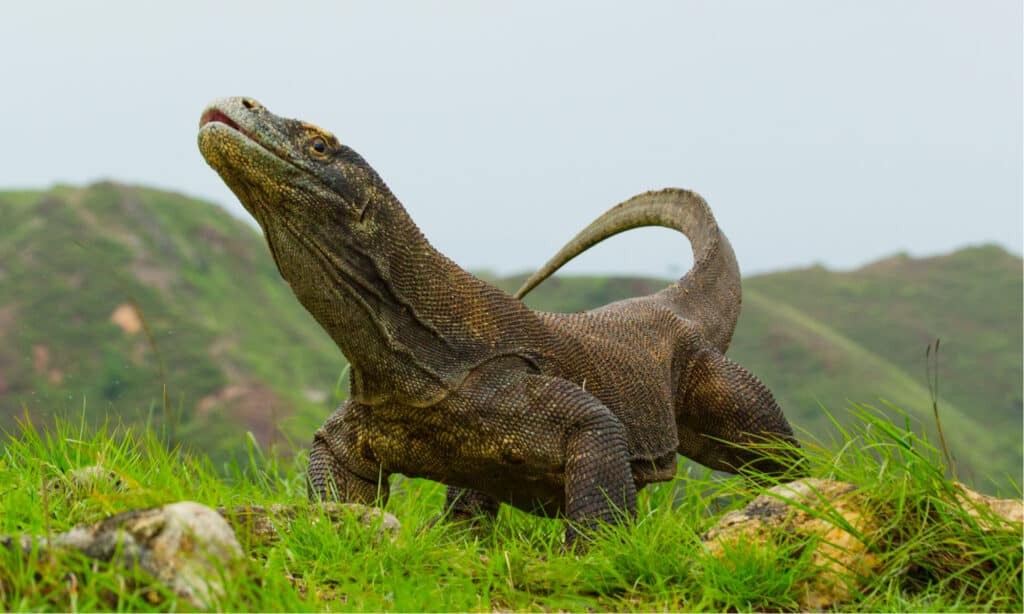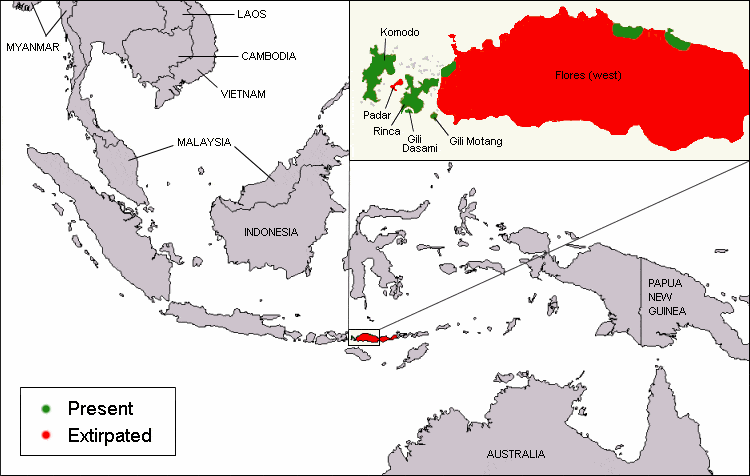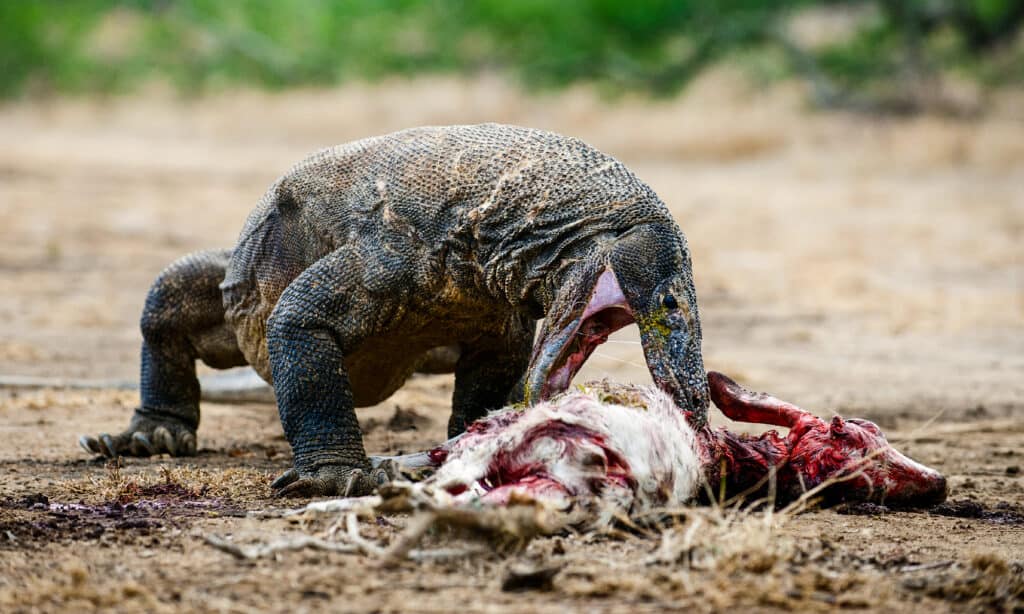Komodo dragons are the largest living lizards on the planet! An average male weighs around 200 pounds and is 8.5 feet long. And the largest Komodo dragon reached an incredible weight of 366 pounds and a massive length of 10.3 feet! Why did it grow into such a monster? And what is being done to conserve these dinosaur-like reptiles? And can you own one as a pet? We answer these questions and more below!

These dinosaur-like reptiles will often grow to 8.5 feet at maturity, but the largest Komodo dragon ever reached 10.3 feet!
©GUDKOV ANDREY/Shutterstock.com
Not Only Big, But Venomous!
Komodo dragons are a species of monitor lizard, the largest of all lizards in the world today. Males grow to 200 pounds and reach lengths of 8.5 feet long. They are native to four islands in Indonesia. These reptiles earned their name from the Island of Komodo where Dutch explorers first saw them. They actually share this island with a population of 2,000 people, many of them descended from exiled convicts. Early accounts by sailors spinning sea yarns claimed they grew to 23 feet long, could fly, and breathed fire! The reality was much less impressive but still interesting enough that when specimens were taken back to Europe and the United States, long lines would stretch throughout zoos as people waited to see them.
Komodo dragons prefer a hot and dry habitat, such as savannah or grassland. They are carnivorous apex predators with no natural threats on the islands. Because of this, the species has been able to grow to an enormous size without competition. The process of creatures adjusting in size to the habitat of an island is called the “island effect.” Some scientists speculate that with global warming, other reptiles will grow to a larger size in the wild as well. These may include snakes, alligators, turtles, and various lizard species.
Hunting
Komodo dragons like to hunt during the day, rest during the hottest times and sleep through the cool nights. Most of the time they are solitary and territorial. However, Komodo dragons come together to hunt in adult groups, which is unusual for reptiles. They will consume any living thing in their ecosystem, ranging from birds to water buffalo. And they have even attacked people on occasion. They are not only the largest lizard species in the world, but the largest living venomous animal of any species. Their venom alone is not deadly to humans, but it creates swelling and intense pain. However, people can die from multiple bites from the dragons’ sharp serrated teeth.

This map shows the four islands where Komodo dragons still roam free.
©Tommyknocker at en.wikipedia / Public domain – License
Komodo Dragon Reproduction
Besides their size, Komodo dragons have a life cycle similar to that of smaller lizards. During mating season, males compete for females and can inflict serious injuries on one another with their sharp claws. If no male mates with a female, she still has the ability to lay eggs that will hatch without any fertilization by a male, with Komodo dragons being one of the few species with this ability. However, eggs laid in those circumstances will all be male offspring. It seems as if this is a sort of backup plan to preserve the species in a situation when females significantly outnumber males.
With or without a sperm donor, in September, females lay a clutch of 20-25 soft, leathery eggs, each about twice the size of a chicken egg. Females protect their nests at first but abandon them after a while. Sometimes predators will eat an entire clutch. Even if left unbothered, 25-50% of the eggs usually do not hatch, which is problematic for the survival of this endangered species.
The young spend their first year mainly in trees, eating insects, birds, and small reptiles and trying to stay hidden from predators, including voracious and cannibalistic adult Komodo dragons. If they survive a year, they typically have reached about 3 feet long and will begin living on the ground. After four more years, they reach full maturity and are often 6.5-8.5 feet long. Some adult Komodo dragons establish and defend a particular territory, whereas others tend to roam around. In the wild, if all goes well, they can live up to about 30 years.

Komodo dragons will eat almost type of meat, even the young of their own species.
©Sergey Uryadnikov/Shutterstock.com
The Biggest Komodo Dragon Ever
The largest recorded Komodo dragon was a male captured in 1928. They gave him to the Sultan of Bima, a region of Indonesia. The Sultan gifted it to an American zoologist. By 1937, it went on to reach an adult weight of 366 pounds and a length of 10.3 feet. Remains were briefly displayed at the St. Louis Zoological Gardens in Missouri. But what made it grow into the largest Komodo dragon ever?
3 Reasons They May Have Grown So Unusually Large:
- It was already a genetic outlier with the potential to grow larger than normal.
- Wealthy royalty took good care of it and a knowledgeable scientist gave it an ideal diet, medical care, and living conditions.
- It did not have to compete with others of its species. Males in the wild fight with one another over females and can get serious injuries and infections that interfere with healthy growth.
Most likely, this fella just had a lot of stars aligned in his favor to help him attain his full potential.

During mating season, males compete for females and can inflict serious injuries on one another with their sharp claws.
©Sergey Uryadnikov/Shutterstock.com
Conservation Of Komodo Dragons
Sadly, due to poaching, degradation of habitat, the exotic animal black market, and natural disasters, the Komodo dragon population has continuously decreased. Today its conservation status is “threatened.” Dutch scientists and explorers tried to preserve the species all the way back in the 1930s by outlawing the sport hunting of them, but money talks and poachers have always found ways to work around the law to collect specimens for zoos, museums, private collectors, and trophy hunters. The Indonesian government has declared Komodo dragons a protected species and set aside the Komodo National Park to ensure their survival. Beginning in 2020, Komodo Island was closed to tourists to help the species recover and the government was considering plans to charge expensive fees to visit the island to help fund conservation efforts. For the moment the total wild Komodo dragon population has stabilized at about 1,400 individuals.
You can support conservation efforts by adopting a Komodo dragon through the World Wildlife Fund. Zoos in the US are also helping to conserve the species. You can see them at the Cincinnati and Toledo Zoos in Ohio, the Louisville Zoo in Kentucky, the Pittsburgh Zoo in Pennsylvania, and the Smithsonian National Zoological Park in Washington D.C. If you would like to see these magnificent creatures in their natural habitat, take the time to investigate a responsible eco-tour company that will not damage the ecosystem you want to observe. Wild Sumatra is an example of such a company in Indonesia. While they do not offer tours to Komodo, they are an example of a community-based ecotourism agency that offers unique access to wilderness areas of the country with other equally fascinating endangered species, such as tigers, orangutans, and tropical bird species.
Can You Have Your Own Komodo Dragon?
Owning a Komodo dragon as a private citizen is not legal, both because they are endangered and because they are extremely dangerous predators. It is possible to own a regular monitor lizard as a pet, and we even have a helpful guide to get you started at this link: Pet Monitor Lizard Guide: What You Need to Know. However, even these require a great deal of space and care and are not recommended for beginning reptile owners. You might want to look for a smaller species, such as an iguana, chameleon, gecko, or others to get started. They might not grow as long as a U-Haul truck, but then again, they won’t need a truckload of food, either.
The photo featured at the top of this post is © iStock.com/MikeLane45
Thank you for reading! Have some feedback for us? Contact the AZ Animals editorial team.






